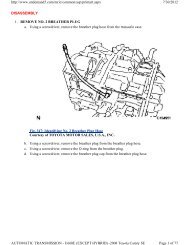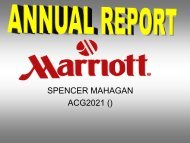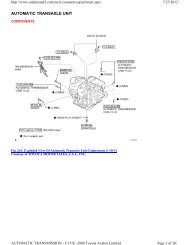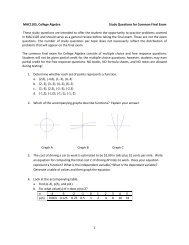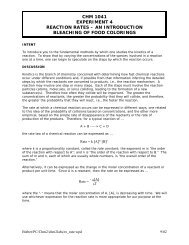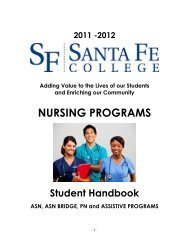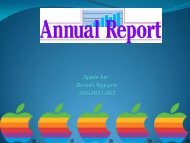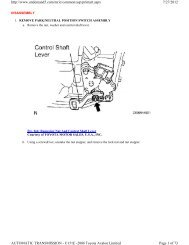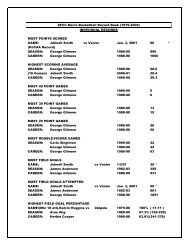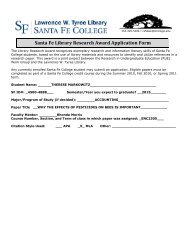Helping to Build a Stronger World! - Santa Fe College
Helping to Build a Stronger World! - Santa Fe College
Helping to Build a Stronger World! - Santa Fe College
You also want an ePaper? Increase the reach of your titles
YUMPU automatically turns print PDFs into web optimized ePapers that Google loves.
<strong>Santa</strong> <strong>Fe</strong> <strong>College</strong><br />
Applied Welding Technologies Program<br />
SYLLABUS<br />
3000 NW 83rd Street<br />
<strong>Build</strong>ing H, Room 38<br />
Gainesville, FL 32606<br />
(352) 395-5253<br />
Email: joseph.mahoney@sfcollege.edu<br />
<strong>Helping</strong> <strong>to</strong> <strong>Build</strong> a <strong>Stronger</strong> <strong>World</strong>! <br />
CURRICULUM PROGRAM SYLLABUS ©2009
SANTA FE COLLEGE<br />
APPLIED WELDING TECHNOLOGY PROGRAM<br />
SYLLABUS<br />
Basic Facts Students Should Know About This Program<br />
The Welding Program here at SFC uses a system of learning called competency-based education (CBE).<br />
This competency-based welding program is centered on teaching specific job skills required in industry.<br />
CBE is a very personalized teaching system that has the following characteristics:<br />
• Ongoing Program<br />
• Open entry - open exit<br />
• Credit granted for work completed<br />
• Evaluation (grades) based on performance<br />
• Fixed content in each course<br />
• Variety of student levels served in each class<br />
This competency-based program has several very important benefits for you:<br />
• You will be given a list of the skills and knowledge needed <strong>to</strong> complete the program<br />
successfully.<br />
• Your performance will not be compared <strong>to</strong> that of other students, but <strong>to</strong> a fixed standard,<br />
which has been set for the program.<br />
• If you have already acquired certain skills required for this program, you may simply<br />
demonstrate this and begin focusing your attention on new skills.<br />
• You will be able <strong>to</strong> review learning materials several times in order <strong>to</strong> attain the skill or<br />
knowledge.<br />
• If you are able <strong>to</strong> attain the skills easily, you may progress through the program faster than the<br />
average person.<br />
What's Required of You: For this system <strong>to</strong> work, you will be expected <strong>to</strong>:<br />
1. Assume the responsibility for your own learning. Your instruc<strong>to</strong>r will give you assistance,<br />
but the actual responsibility for learning rests with you, the student.<br />
2. Utilize the materials provided for you. The program's resources have been carefully chosen<br />
and developed <strong>to</strong> help you learn.<br />
3. Devote your energy <strong>to</strong> attaining the skills and knowledge required for your program.<br />
The Instruc<strong>to</strong>r's Role: The instruc<strong>to</strong>rs in SFC's Welding Program work with students individually and<br />
guide them through the learning process with the help of many different learning resources. In CBE,<br />
instruc<strong>to</strong>rs are often referred <strong>to</strong> as learning managers because they manage the activities in the program and<br />
facilitate the learning process. If you are having difficulty, you should go <strong>to</strong> your instruc<strong>to</strong>r with your<br />
problem. The instruc<strong>to</strong>r's goal is <strong>to</strong> find the most effective way <strong>to</strong> help you learn the tasks in the program.<br />
Page One
How Your Grade is Computed in This Program: Your grade will be computed using four different items.<br />
These include Knowledge Tests, Performance Tests, Class Participation and Attendance.<br />
Knowledge Tests: These tests measure what you know about the task you are working on. They cover<br />
important information like safety and technical information, which is necessary <strong>to</strong> complete the task safely<br />
and efficiently.<br />
Performance Tests: These tests measure how well you have performed a task. These tests take place<br />
at the end of a task. (See sample Page Three). These tests also compare your work <strong>to</strong> a set standard,<br />
displayed on the weld sample rack.<br />
Class Participation: This will be covered in detail later in this syllabus.<br />
Attendance: Your instruc<strong>to</strong>r may choose <strong>to</strong> use your attendance in the calculation of your grade.<br />
Getting <strong>to</strong> work on time and when you are scheduled is an important employability skill. You will practice<br />
this skill while attending classes in the Welding Program. If you are going <strong>to</strong> be late or must miss class, call<br />
your instruc<strong>to</strong>r and explain your situation.<br />
The following policy will be used when attendance is computed in<strong>to</strong> your grade:<br />
1. A student will be allowed three (3) absences per term.<br />
2. Each following absence shall equal one percentage point subtracted from the student's term end<br />
grade.<br />
3. Arriving <strong>to</strong> class late or leaving early shall equal .5 (1/2) percentage point subtracted from the<br />
student's term end grade.<br />
Remember, attendance is the most important part of your training here at SFC. If you are not in class, you<br />
cannot practice your skills. You also loose valuable access <strong>to</strong> the welding lab, the program resources and the<br />
feedback and guidance from your instruc<strong>to</strong>r. You pay for your time in class - - don't waste it.<br />
The Grade Calculation: Your grade for each course will be calculated by using the average of all test scores<br />
(knowledge and Performance). This average will be expressed as a percentage. Attendance points will then<br />
be subtracted from this percentage. The final percent score will then be converted <strong>to</strong> a letter grade using this<br />
table.<br />
95% and higher = A<br />
86% <strong>to</strong> 94% = B<br />
71% <strong>to</strong> 85% = C<br />
65% <strong>to</strong> 70% = D<br />
64% and under = F<br />
General Program Policies: All welding students will follow the SFC Student Code of Conduct.<br />
Tobacco Policy: Smoking is not permitted in any SFC building. There will be absolutely no spitting allowed<br />
in the welding area or the corridor, which serves the main entrance <strong>to</strong> the Welding Lab. No spit containers of<br />
any type will be allowed in the Welding Program areas. In other words, if you can't use smokeless <strong>to</strong>bacco<br />
without spitting, don't use it while you are in the Welding Program areas.<br />
Insurance for Students: Student health insurance is a wise investment while you are attending classes here at<br />
SFC. Information on student insurance is available through the Student Activities Program. Pay them a visit<br />
in <strong>Build</strong>ing S, Room 147 for more information on your insurance options.<br />
Page Two
Locker Policy: Lockers are available for your use here in the Welding Program. You must follow these<br />
procedures in order <strong>to</strong> use one of the program lockers:<br />
1. You must sign up for your locker through your instruc<strong>to</strong>r. You are responsible <strong>to</strong> have your<br />
name placed on the locker assignment list by your instruc<strong>to</strong>r. Returning students must also<br />
have their names applied <strong>to</strong> the locker assignment list by their instruc<strong>to</strong>r.<br />
2. SFC is not responsible for personal items left in lockers.<br />
3. All lockers must be vacated by the last class day of the term.<br />
4. If you have not signed up for a locker as per number one above, your lock may be removed.<br />
Removal of your lock usually results in the destruction of the lock.<br />
Program Courses and Curriculum: The courses, which make up the Welding Program, will be studied in the<br />
prescribed order. Exceptions <strong>to</strong> this are: 1) your employer makes a written request on company letterhead<br />
stating his or her need for you <strong>to</strong> study a specific course because of a requirement with your job. 2) Your<br />
instruc<strong>to</strong>r may need <strong>to</strong> rearrange the GMAW, FCAW and GTAW courses due <strong>to</strong> equipment demands within<br />
the Welding Lab. The course sequence is as follows:<br />
Course Sequence Course Title<br />
1 Intro <strong>to</strong> Welding<br />
2 Shielded Metal Arc Welding I<br />
3 Shielded Metal Arc Welding II<br />
4 Vertical Structural Welding Certification<br />
5 Overhead Structural Welding Certification<br />
6 Intro <strong>to</strong> Inert Gas Welding<br />
7 Gas Metal Arc Welding<br />
8 Flux Cored Arc Welding<br />
9 Gas Tungsten Arc Welding<br />
Variable 10 Blueprint Reading & Employability Skills<br />
11 Intro <strong>to</strong> Pipe Welding<br />
12 Pipe Welding Certification<br />
13 Gas Tungsten Arc Welding, Pipe<br />
How <strong>to</strong> Project the Date You Should Finish an Assigned Task: Staying on schedule with your course<br />
work is manda<strong>to</strong>ry if you want <strong>to</strong> earn a good grade. You will need several things <strong>to</strong> figure out the date you<br />
should finish an assigned task. These include: 1) the length of the task, or what we call average hours. You<br />
have this information on your course outline. 2) A calendar. These are posted in the lab and classroom. 3)<br />
The average number of hours per day you are in the Welding Program. Use this chart <strong>to</strong> figure your average<br />
hourly attendance per day.<br />
If you are taking: You Attend Class: Your Average # of Hours in Class Per Day Is:<br />
1 course 6 hours per week = 1.2 average hours per day<br />
2 courses 12 hours per week = 2.4 average hours per day<br />
3 courses 18 hours per week = 3.6 average hours per day<br />
4 courses 24 hours per week = 4.8 average hours per day<br />
5 courses 30 hours per week = 6.0 average hours per day<br />
6 courses 36 hours per week = 7.2 average hours per day<br />
Page Three
How <strong>to</strong> Project the Date You Should Finish an Assigned Task (Continued): To calculate the date you<br />
should finish a task you now use this formula:<br />
Number of Hours in Task<br />
÷ Average Hours in Class Per Day<br />
Number of Work Days on Calendar <strong>to</strong> Finish Task<br />
Here's an example. A student is taking one course in the term. The student will work on the first task in the<br />
program, task #0101, Practice Basic Shop Safety (see Course Outline). This task takes an average of 18<br />
hours <strong>to</strong> complete. The equation is:<br />
18 (# of hours in task)<br />
÷ 1.2 (average hours in class per day)<br />
15 work days on calendar <strong>to</strong> finish task<br />
You are responsible for calculating the number of workdays you have <strong>to</strong> complete each task. It is also your<br />
responsibility <strong>to</strong> use the number of workdays you have <strong>to</strong> complete the task and a calendar <strong>to</strong> come up with a<br />
date in which the task should be completed. This date must be recorded on your course outline along with the<br />
date that you started the task. Using this simple procedure will keep you on time as you work through your<br />
welding curriculum.<br />
Graduation Requirement, Taking a Welding Certification Test: Starting in Fall Term 2008 students are<br />
required <strong>to</strong> complete a welding certification test as a program graduation requirement. The Welding<br />
Program's Advisory Committee recommended this requirement because it feels that students need <strong>to</strong> take a<br />
certification test <strong>to</strong> better prepare them for the world of work and <strong>to</strong> experience the real pressures of<br />
certification testing with an independent welding inspec<strong>to</strong>r.<br />
Welder certification is an incredibly complicated subject. There are an infinite number of welder<br />
certifications available in this broad industry called welding. Students in this program study for several<br />
different certification tests in the curriculum. Other tests are available for industry workers and their<br />
companies. During your course of study here at SFC, you will gain a comprehensive understanding of the<br />
welding certification process and the specific limits of a welding certification. With this new knowledge you<br />
will choose the welding certification test you will take for your graduation requirement which best suites<br />
your skills and your future employment opportunities.<br />
Welding Certification Test <strong>Fe</strong>es: There are two different certification test fee schedules available here at the<br />
SFCC Welding Program. The following is a brief description of each.<br />
Certification testing for Currently Enrolled Students: These tests will be conducted under the<br />
guidelines of the American Welding Society's Certified Welder Program (SFC's Welding Lab is an<br />
accredited testing facility for the American Welding Society). Daytime students will have two test dates<br />
scheduled per term. The dates will fall at midterm and on the last week of the term. Evening students will<br />
have a scheduled test date at the end of the term and will have the option of testing at midterm through the<br />
day classes. The following test fees are for core curriculum certification tests only.<br />
Test fee for two position plate or one-6G pipe<br />
$30.00 fee <strong>to</strong> AWS<br />
$100.00 fee <strong>to</strong> Welding Inspec<strong>to</strong>r<br />
* $130.00 <strong>to</strong>tal fee *<br />
Test fee for one position plate<br />
$30.00 fee <strong>to</strong> AWS<br />
$75.00 fee <strong>to</strong> Welding Inspec<strong>to</strong>r<br />
* $105.00 <strong>to</strong>tal fee*<br />
Page Four<br />
The paperwork for these tests will come from AWS National Headquarters in Miami, Florida.
Certification for those not currently enrolled in SFC welding courses: A variety of welding<br />
certification tests are available <strong>to</strong> the public at large through SFC's Welding Program. The fee for a basic two<br />
position, limited thickness, low carbon steel plate test or a 6G limited thickness low carbon steel pipe test is<br />
$345.00. Contact the Welding Program office for further details.<br />
BEING TO CLASS ON TIME IS IMPORTANT!<br />
Many of the rules and procedures that are used in the Welding Program are a direct result of the rules<br />
and procedures used in industry. Since this is a training program, some compromises do take place <strong>to</strong> insure<br />
students' freedom of choice.<br />
In industry, a worker who habitually arrives late for his or her job will be disciplined through a<br />
variety of methods. One method is <strong>to</strong> dock the worker's pay for the tardiness. Another method would be <strong>to</strong><br />
discharge the worker from the job.<br />
We all know that everyone will have a situation or an emergency that will now and then cause us <strong>to</strong><br />
be late. The Welding Program has a cushion built in<strong>to</strong> the grading system, which allows for these infrequent<br />
cases (3 free points).<br />
Coming <strong>to</strong> class late or showing up <strong>to</strong> work late sends a signal <strong>to</strong> your supervisor and <strong>to</strong> all those<br />
around you. It is important that you understand that the signal is not a positive one. The signal you send by<br />
coming late says that you are not concerned with this portion of your education or your employment. We<br />
know that for your training <strong>to</strong> be successful you as a student must give 100%. When you come <strong>to</strong> class late,<br />
you are au<strong>to</strong>matically reducing your 100% effort. The <strong>College</strong> cannot make up this loss on your part. This is<br />
your responsibility and yours alone.<br />
Because the Welding Program tries <strong>to</strong> maintain a work environment a penalty is placed on tardiness.<br />
Students arriving <strong>to</strong> class late will waive their access <strong>to</strong> the instruc<strong>to</strong>r during the lab period for that class.<br />
Please see your instruc<strong>to</strong>r if you have had an emergency or a situation that was beyond your control.<br />
Remember we are here <strong>to</strong> help, but you must do your part in order for you <strong>to</strong> be successful!<br />
Instruc<strong>to</strong>r Office Hours<br />
Your instruc<strong>to</strong>r's office hours are posted on the bulletin board located outside the main entrance door<br />
<strong>to</strong> the H-38 Welding Lab. Your instruc<strong>to</strong>r's phone number and e-mail address are posted on the office hours<br />
form.<br />
You may have <strong>to</strong> set up an appointment <strong>to</strong> visit with your instruc<strong>to</strong>r during office hours. Talk with<br />
your instruc<strong>to</strong>r <strong>to</strong> see how office hours visits are handled.<br />
NOTE TAKING IS REQUIRED!<br />
Page Five
In industry workers are often given oral instructions. Whether you are a banker or a welder oral<br />
communication is a major part of each workday. Taking notes helps workers refresh their memory. When<br />
your supervisor directs you through a list of jobs, the supervisor expects you <strong>to</strong> complete them all. Your boss<br />
does not want you <strong>to</strong> come back and ask, "What was the second and third thing you wanted me <strong>to</strong> do on that<br />
list?" Going back <strong>to</strong> your supervisor with this type of question would not compliment your work skills.<br />
Having a few notes will eliminate the need <strong>to</strong> approach your boss with this unnecessary question.<br />
Taking notes can also save you from embarrassing mistakes. When you save your notes and follow<br />
your notes exactly as directed by your supervisor, you have a permanent record of the oral instructions<br />
presented <strong>to</strong> you by your boss. Remember, when taking notes review your written information with your<br />
supervisor before your conversation is completed!<br />
Your instruc<strong>to</strong>r will be directing you through a variety of activities each class period. It is your<br />
responsibility <strong>to</strong> take notes while the instruc<strong>to</strong>r works with you. This note taking technique will improve<br />
your success in the Welding Program and will prepare you for your next job.<br />
A pocket spiral notebook is most often used by trades’ people in the construction and metal trades<br />
industry. These notebooks fit in the breast pocket of your shirt or jacket. This type of notebook is highly<br />
recommended, but you may use any type of resource.<br />
Remember, taking notes will help you improve the speed at which you learn your welding skills<br />
and will prepare you for good communication skills on the job. Don't neglect this student obligation!<br />
Page Six<br />
Class Participation, The 4 th Component Of Your Grade
Starting Spring Term 2004 a 4 th component will be used <strong>to</strong> calculate your grade. This<br />
is an addition <strong>to</strong> the “How Your Grade is Computed in This Program” section of this<br />
Syllabus found on page two. Since the Welding Program is primarily a job prepara<strong>to</strong>ry<br />
program this item in the grade calculation has been introduced <strong>to</strong> help students better prepare<br />
them for what will be expected of them in their future employer’s workplace.<br />
Class Participation will require little or no changes for most students in the Program.<br />
However, every student should be aware that their participation, not just attendance and<br />
completion of tests, will have a serious affect on their grade just as it would have an affect on<br />
an employee’s standing in a job environment. Here are just a few examples of what is<br />
expected of students who are demonstrating good class participation skills:<br />
Attention <strong>to</strong> classroom and lab discussions<br />
Courteous interaction in discussions<br />
Efficient use of time in lab activities<br />
Accurately following daily class schedules<br />
Using class time for accomplishment of welding assignments<br />
Efficient use of personal and scheduled break times<br />
Students who have difficulty with class participation skills will have points subtracted<br />
from their term end grade and may be required <strong>to</strong> see other SFC staff <strong>to</strong> continue their studies<br />
in the program. The following policy will apply:<br />
1 st Occurrence- Instruc<strong>to</strong>r meeting, 1 point subtracted from term end grades.<br />
2 nd Occurrence- Instruc<strong>to</strong>r meeting, 3 points subtracted from term end grades.<br />
3 rd Occurrence- Instruc<strong>to</strong>r meeting, 6 points subtracted from term end grades.<br />
4 th Occurrence- Referral <strong>to</strong> Student Advisor, and or Department Direc<strong>to</strong>r.<br />
Remember that the Program wants all SFC Welding Students, for their sake, <strong>to</strong> be successful in the<br />
jobs they will hold in the future. Practicing good participation skills while studying in the Welding Program<br />
will help students have success when they make the transition from student <strong>to</strong> employee.<br />
Page Seven
SFC<br />
WELDING PROGRAM<br />
TEXTBOOK, TOOL AND CLOTHING LIST<br />
Listed below is the cost of tuition, books, <strong>to</strong>ols and clothing. It is impossible <strong>to</strong> give exact prices on some<br />
items, as the prices change from term <strong>to</strong> term. Some prices depend on the quality of the product. We<br />
recommend that high quality safety products be purchased.<br />
I. TUITION COST (you need <strong>to</strong> see a staff member in The Construction and Technical Programs office<br />
for up <strong>to</strong> date tuition and lab fee information)<br />
II. TEXTBOOKS (available at SFC Books<strong>to</strong>re)<br />
A. The Procedure Handbook Of Arc Welding 14 th Edition, Lincoln Electric Company<br />
Approximately $39.00<br />
C. How To Read Shop Drawings (Author and Publisher: Lincoln Electric)<br />
Approximately $14.00<br />
III. TOOLS AND CL0THING (These items are available at a wide variety of s<strong>to</strong>res and suppliers. Their<br />
cost will vary by style, model, etc.) Approximately $250.00<br />
A. Pen and/or pencil I. Oxy-fuel welding/cutting goggles, #5 lens<br />
B. Spiral note pad J. Striker<br />
C. Leather work books, K. Tip Cleaners<br />
ankle high minimum L. Pliers<br />
D. Cot<strong>to</strong>n or cot<strong>to</strong>n blend pants M. Welding helmet with chipping lens and<br />
and shirts #10 filter lens<br />
E. Welding cap or hat N. Chipping hammer<br />
F Safety glasses, clear lenses O. Tape measure, 6 ft. minimum<br />
G. Welding jacket or leathers P. Soaps<strong>to</strong>ne<br />
H. Leather welding gloves, Q. Wire brush<br />
gauntlet type R. Ear Plugs<br />
S. TIG Gloves<br />
IV CERTIFICATION TEST GRADUATION REQUIREMENT (Choose One)<br />
A. One Position Plate Test $105.00<br />
B. Two Position Plate Test or 6G Pipe Test $130.00<br />
Local Welding Supply Companies:<br />
Airgas South, 2330A NE Waldo Road, Phone: 338-7508<br />
Praxair Distribution SE, 933 SE 4 th Street, Phone: 372-8417<br />
Strate Welding Supply, 1910 NE 27 th Ave., Phone: 377-2408<br />
Page Eight





